Guess Hoo-hoo It Is 🦉
Guess hoo-hoo it is 🦉
The owlfish, named for the size of its large eyes relative to its head, lives throughout the North Pacific. These species are in the family Bathylagidae and are relatively common in the deep sea, living at depths of over 6,000 meters (19,685 feet). In Monterey Bay, we observe these fish between a few hundred meters to over 2,000 meters (6,560 feet)
More Posts from Simplyphytoplankton and Others

Turtle by TomMeyer

Darwin is most famous for his theory of evolution. But did you know that much of his life’s work was influenced by his time at sea?
In the spirit of Darwin Day, here is one of his observations of bioluminescent plankton while aboard the HMS Beagle on October 24, 1832:
“The night was pitch dark, with a fresh breeze. — The sea from its extreme luminousness presented a wonderful & most beautiful appearance; every part of the water, which by day is seen as foam, glowed with a pale light. The vessel drove before her bows two billows of liquid phosphorus, & in her wake was a milky train. — As far as the eye reached, the crest of every wave was bright; & from the reflected light, the sky just above the horizon was not so utterly dark as the rest of the Heavens.” Charles Darwin
Learn more about Darwin’s connection to the ocean from this article at the Ocean Portal.
Photo Credit: unknown, Turin Museum of Human Anatomy
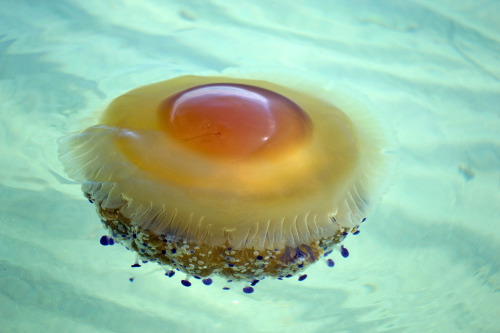

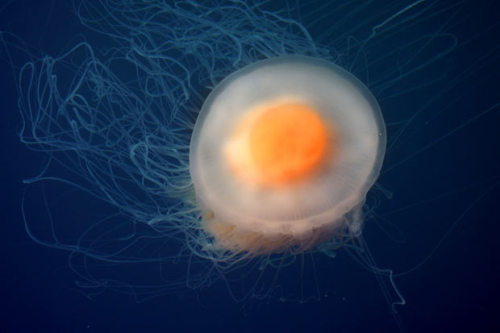
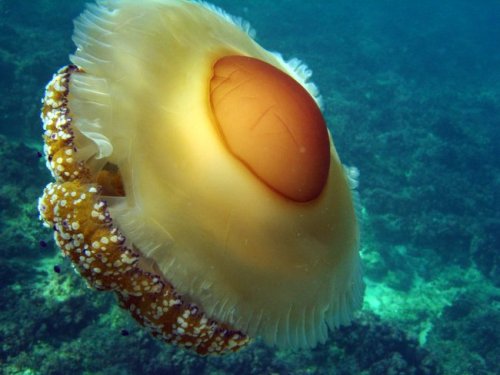
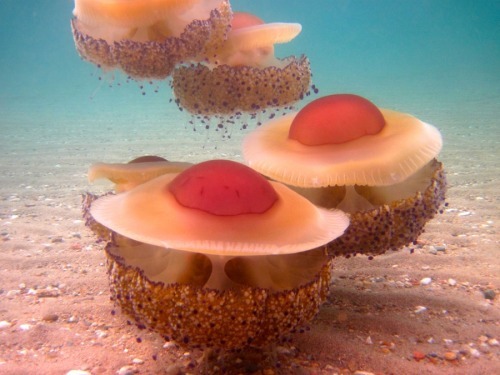
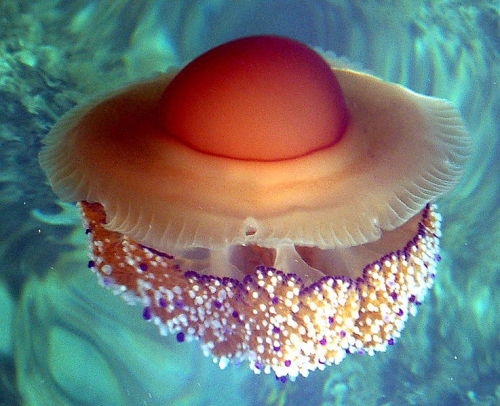
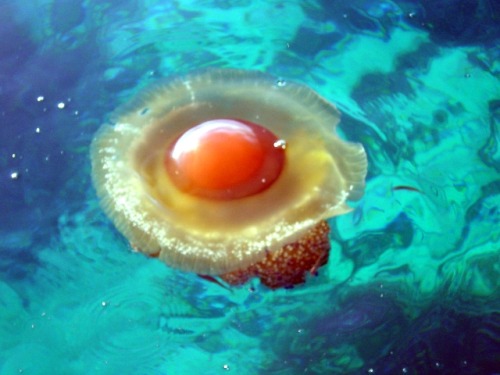
Fried Egg Jellyfish Are Kind of Adorable – & That’s No Yolk.
There are two species that hold the whimsical title of “Fried Egg Jellyfish”: Phacellophora camtschatica and Cotylorhiza tuberculata though the two are quite different from each other in all aspects beside appearance.
Phacellophora camtschatica is a huge jelly that prefers colder waters. It’s bell can reach up to 2 ft across and its dozens of tentacles reach over 20 ft long! If you don’t think this floating egg creature looks very menacing, you’d be right. It has a very weak sting and many small crustaceans take advantage of the jelly by riding on its bell (breakfast to go…?) while snatching up extra food.
Cotylorhiza tuberculata is a much smaller jellyfish that hangs out in warmer waters. It only reaches about 35 cm in diameter, so don’t go for this Fried Egg Jelly if you want a big breakfast. Unlike most jellyfish, C. tuberculata can swim on its own, without relying on the currents for movement. It’s sting (if you can even call it that) is so feeble that it has very little to no effect on humans at all. I mean, it does look like a breakfast food, after all… how powerful could it be?

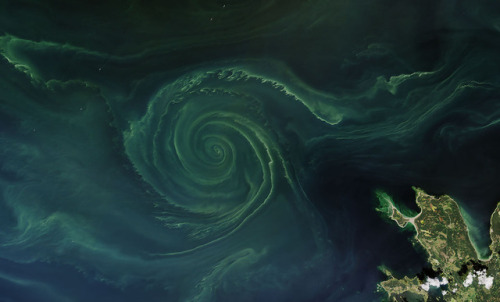
Blooms in the Baltic
Every summer, phytoplankton – microscopic plant-like organisms – spread across the North Atlantic, with blooms spanning hundreds and sometimes thousands of miles. Nutrient-rich, cooler waters tend to promote more growth among marine plants and phytoplankton than is found in tropical waters. Blooms this summer off Scandinavia seem to be particularly intense.
On July 18, 2018, the Operational Land Imager (OLI) on Landsat 8 acquired a natural-color image of a swirling green phytoplankton bloom in the Gulf of Finland, a section of the Baltic Sea. Note how the phytoplankton trace the edges of a vortex; it is possible that this ocean eddy is pumping up nutrients from the depths.
Though it is impossible to know the phytoplankton type without sampling the water, three decades of satellite observations suggest that these green blooms are likely to be cyanobacteria (blue-green algae), an ancient type of marine bacteria that capture and store solar energy through photosynthesis (like plants).
In recent years, the proliferation of algae blooms in the Baltic Sea has led to the regular appearance of “dead zones” in the basin. Phytoplankton and cyanobacteria consume the abundant nutrients in the Baltic ¬and deplete the oxygen. According to researchers from Finland’s University of Turku, the dead zone this year is estimated to span about 70,000 square kilometers (27,000 square miles).
Read more: https://go.nasa.gov/2uLK4aZ
Make sure to follow us on Tumblr for your regular dose of space: http://nasa.tumblr.com.
Don’t underestimate the importance of phytoplankton!

9 Ocean Facts You Likely Don’t Know, but Should
Earth is a place dominated by water, mainly oceans. It’s also a place our researchers study to understand life. Trillions of gallons of water flow freely across the surface of our blue-green planet. Ocean’s vibrant ecosystems impact our lives in many ways.
In celebration of World Oceans Day, here are a few things you might not know about these complex waterways.
1. Why is the ocean blue?

The way light is absorbed and scattered throughout the ocean determines which colors it takes on. Red, orange, yellow,and green light are absorbed quickly beneath the surface, leaving blue light to be scattered and reflected back. This causes us to see various blue and violet hues.
2. Want a good fishing spot?

Follow the phytoplankton! These small plant-like organisms are the beginning of the food web for most of the ocean. As phytoplankton grow and multiply, they are eaten by zooplankton, small fish and other animals. Larger animals then eat the smaller ones. The fishing industry identifies good spots by using ocean color images to locate areas rich in phytoplankton. Phytoplankton, as revealed by ocean color, frequently show scientists where ocean currents provide nutrients for plant growth.
3. The ocean is many colors.

When we look at the ocean from space, we see many different shades of blue. Using instruments that are more sensitive than the human eye, we can measure carefully the fantastic array of colors of the ocean. Different colors may reveal the presence and amount of phytoplankton, sediments and dissolved organic matter.
4. The ocean can be a dark place.
About 70 percent of the planet is ocean, with an average depth of more than 12,400 feet. Given that light doesn’t penetrate much deeper than 330 feet below the water’s surface (in the clearest water), most of our planet is in a perpetual state of darkness. Although dark, this part of the ocean still supports many forms of life, some of which are fed by sinking phytoplankton.
5. We study all aspects of ocean life.

Instruments on satellites in space, hundreds of kilometers above us, can measure many things about the sea: surface winds, sea surface temperature, water color, wave height, and height of the ocean surface.
6. In a gallon of average sea water, there is about ½ cup of salt.

The amount of salt varies depending on location. The Atlantic Ocean is saltier than the Pacific Ocean, for instance. Most of the salt in the ocean is the same kind of salt we put on our food: sodium chloride.
7. A single drop of sea water is teeming with life.

It will most likely have millions (yes, millions!) of bacteria and viruses, thousands of phytoplankton cells, and even some fish eggs, baby crabs, and small worms.
8. Where does Earth store freshwater?

Just 3.5 percent of Earth’s water is fresh—that is, with few salts in it. You can find Earth’s freshwater in our lakes, rivers, and streams, but don’t forget groundwater and glaciers. Over 68 percent of Earth’s freshwater is locked up in ice and glaciers. And another 30 percent is in groundwater.
9. Phytoplankton are the “lungs of the ocean”.

Just like forests are considered the “lungs of the earth”, phytoplankton is known for providing the same service in the ocean! They consume carbon dioxide, dissolved in the sunlit portion of the ocean, and produce about half of the world’s oxygen.
Want to learn more about how we study the ocean? Follow @NASAEarth on twitter.
Make sure to follow us on Tumblr for your regular dose of space: http://nasa.tumblr.com.

Silence and calmness can be extremely moving. #Whale #MexicoPelagico #PelagicLife #ocean #nature #whale #underwater #mexico Photo by @rodrigofriscione
Trip to the Osa Pennisula
Trip
Rocks
Mangrove
Stolen
On Friday at around 5:50 am., we left for our first IFSA-Butler organized trip. The bus drive was hours long, but we made stops for breakfast and to see indigenous artifacts. We stopped at the Parque de las Esferas. Here, we saw large spherical rocks that were shaped by Costa Rica’s indigenous peoples hundreds and thousands of years ago. They shaped the rocks by placing them in streams or rivers and used smalls rocks of different shapes to hit them. They were used to make maps of the stars, commerce, and many other things. Unsurprisingly, over the years many myths have been created about their origins and purposes. Some people say that they were made by UFOs or gods.
Later after lunch, we got a boat tour of the Térraba-Sierpe Mangrove, the largest mangrove in Costa Rica. We saw many species of birds: Baltimore Orioles, turkey buzzards, woodpeckers, various species of herons, and many more as well as more wildlife like a Jesus lizard (but we did not see it walk on water as it was on a tree branch) and different species of mangroves such as the red and black mangroves. After about an hour and a half boat ride, we got to the resort called the Corcovado Adventure Tent Camp. After we were settled in, we went to the beach for a little bit. After dinner, we were told to go back to our tents and make sure that everything was still there. All of my stuff was still in our tent, but when I returned to the central pavilion, I learned that the guys in the tent next to ours had both of their bags stolen, including a wallet, a laptop, an EpiPen, and most of their clothing. After about 45 minutes, a group of us went on a night walk that lasted about an hour. When we returned, Rodney, our program director, had an announcement to make. He decided that since one of the thing’s stolen was an EpiPen for an allergy to bees and the student did not have another one with him, we would leave on Saturday right away breakfast, instead of continuing with the rest of the trip as planned and returning to Heredia Sunday night. On our way home Saturday, we stopped at a bridge over el río Tárcoles to look at the crocodiles that gather in the river below.






Underwater creatures: Photographer Marty Snyderman captures unique behaviors
Underwater photographer Marty Snyderman’s fascinating body of work brings to life some of the more unique behaviors of the animals of the deep. Snyderman has dedicated his professional life to documenting these creatures — including those that clean other fish, guard fertilized eggs in their mouths, and “fish” for their dinner using a natural worm or fishlike lure incorporating their own body as a fishing rod. In order to find such intriguing creatures, Snyderman, 67, said a lot of discussion must first take place between himself and fishermen, scientists, photographers or even local diving instructors. When photographing his subjects, he tries to stay within one or two feet of them whenever possible, something he admits can be tricky, given the sensitivity of the fish, whales, manta rays and other subjects. (Caters News)
Photography by Marty Snyderman
See more photos of underwater creatures and our other slideshows on Yahoo News.

Phytoplankton: An overview of the small, plant-like organisms that make the world go round.
http://becausephytoplankton.blogspot.com/2017/11/what-are-phytoplankton.html?spref=tw
Image Credit: NASA/Goddard/Aqua/MODIS via Flickr
-
 the-seas-incarnadine liked this · 1 month ago
the-seas-incarnadine liked this · 1 month ago -
 crobody reblogged this · 1 month ago
crobody reblogged this · 1 month ago -
 delightful-69 liked this · 2 months ago
delightful-69 liked this · 2 months ago -
 tofucasserole liked this · 2 months ago
tofucasserole liked this · 2 months ago -
 fish-trivia reblogged this · 2 months ago
fish-trivia reblogged this · 2 months ago -
 centeotl888-blog liked this · 2 months ago
centeotl888-blog liked this · 2 months ago -
 n-a2202 liked this · 2 months ago
n-a2202 liked this · 2 months ago -
 phoenixinthewaves liked this · 3 months ago
phoenixinthewaves liked this · 3 months ago -
 petedavis64 liked this · 3 months ago
petedavis64 liked this · 3 months ago -
 akasanata reblogged this · 3 months ago
akasanata reblogged this · 3 months ago -
 sauc3pan reblogged this · 3 months ago
sauc3pan reblogged this · 3 months ago -
 sauc3pan liked this · 3 months ago
sauc3pan liked this · 3 months ago -
 sharkselfies liked this · 3 months ago
sharkselfies liked this · 3 months ago -
 ofthebluestskies liked this · 3 months ago
ofthebluestskies liked this · 3 months ago -
 asecretvice reblogged this · 3 months ago
asecretvice reblogged this · 3 months ago -
 starside-sea reblogged this · 3 months ago
starside-sea reblogged this · 3 months ago -
 walkthebass reblogged this · 3 months ago
walkthebass reblogged this · 3 months ago -
 hypermobilityherpyhour liked this · 3 months ago
hypermobilityherpyhour liked this · 3 months ago -
 mollyhawk liked this · 3 months ago
mollyhawk liked this · 3 months ago -
 lazykcdoodler reblogged this · 3 months ago
lazykcdoodler reblogged this · 3 months ago -
 lazykcdoodler liked this · 3 months ago
lazykcdoodler liked this · 3 months ago -
 mrcramique-blog liked this · 3 months ago
mrcramique-blog liked this · 3 months ago -
 methoxyacetyltryptamine reblogged this · 3 months ago
methoxyacetyltryptamine reblogged this · 3 months ago -
 methoxyacetyltryptamine liked this · 3 months ago
methoxyacetyltryptamine liked this · 3 months ago -
 yotzuyu reblogged this · 3 months ago
yotzuyu reblogged this · 3 months ago -
 technicolorcrows reblogged this · 3 months ago
technicolorcrows reblogged this · 3 months ago -
 bugbugs-posts reblogged this · 3 months ago
bugbugs-posts reblogged this · 3 months ago -
 bugbugs-posts liked this · 3 months ago
bugbugs-posts liked this · 3 months ago -
 nerf-herders reblogged this · 3 months ago
nerf-herders reblogged this · 3 months ago -
 kittenbiscuitz liked this · 3 months ago
kittenbiscuitz liked this · 3 months ago -
 thedreideldiaries liked this · 3 months ago
thedreideldiaries liked this · 3 months ago -
 pineacabple reblogged this · 3 months ago
pineacabple reblogged this · 3 months ago -
 autismwonderland reblogged this · 3 months ago
autismwonderland reblogged this · 3 months ago -
 shofarsogood reblogged this · 3 months ago
shofarsogood reblogged this · 3 months ago -
 vockoronst liked this · 3 months ago
vockoronst liked this · 3 months ago -
 mailedman liked this · 3 months ago
mailedman liked this · 3 months ago -
 blood-starved-beast reblogged this · 3 months ago
blood-starved-beast reblogged this · 3 months ago -
 sparkleyshark reblogged this · 3 months ago
sparkleyshark reblogged this · 3 months ago -
 frootytomato liked this · 3 months ago
frootytomato liked this · 3 months ago -
 kittyofinsanity liked this · 3 months ago
kittyofinsanity liked this · 3 months ago -
 sweetteamadness liked this · 3 months ago
sweetteamadness liked this · 3 months ago -
 technicrowlor liked this · 3 months ago
technicrowlor liked this · 3 months ago -
 notasouleater reblogged this · 3 months ago
notasouleater reblogged this · 3 months ago -
 everest81 liked this · 3 months ago
everest81 liked this · 3 months ago -
 peergrin liked this · 3 months ago
peergrin liked this · 3 months ago -
 the-flailing-octopus reblogged this · 3 months ago
the-flailing-octopus reblogged this · 3 months ago -
 detroitlib liked this · 3 months ago
detroitlib liked this · 3 months ago -
 peachycloudcats liked this · 3 months ago
peachycloudcats liked this · 3 months ago -
 mlleclaudine reblogged this · 3 months ago
mlleclaudine reblogged this · 3 months ago

Blog dedicted to phytoplankton. Phytoplankton are microscopic organisms that are responsible for half of the photosynthesis that occurs on Earth. Oh, and they look like art... Follow to learn more about these amazing litter critters! Caution: Will share other ocean science posts!Run by an oceanographer and phytoplankton expert. Currently a postdoctoral researcher.Profile image: False Colored SEM image of Emiliania huxleyi, a coccolithophore, and the subject of my doctoral work. Credit: Steve Gschmeissner/ Science Photo Library/ Getty ImagesHeader image: Satellite image of a phytoplankton bloom off the Alaskan Coast, in the Chukchi SeaCredit: NASA image by Norman Kuring/NASA's Ocean Color Web https://earthobservatory.nasa.gov/images/92412/churning-in-the-chukchi-sea
158 posts